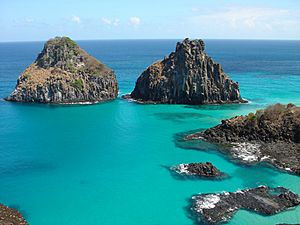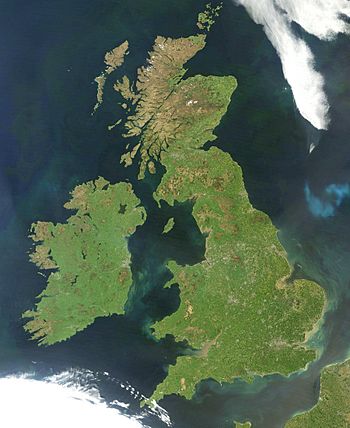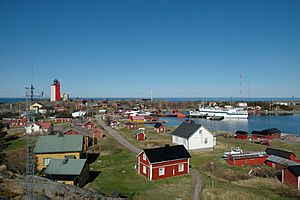Island facts for kids

An island is a piece of land completely surrounded by water. It's like a small world of its own! Islands can be found in oceans, lakes, or even rivers. Very tiny islands have special names like islets or cays. A small island off the coast might be called a holm. A group of islands close together, like the Philippines, is called an archipelago.
There are two main types of islands in the sea: continental and oceanic. There are also artificial islands, which are built by people.
Contents
How are Islands Different from Continents?
Greenland is the world's largest island. It covers over 2.1 million square kilometers. Australia is the world's smallest continent, with an area of 7.6 million square kilometers. There isn't a set size that separates an island from a continent.
The main difference is in their geology. Continents sit on thick pieces of Earth's crust called continental lithosphere. These are part of huge moving sections called tectonic plates. Islands are either part of a continent's crust or they are extensions of the thinner oceanic crust, like volcanic islands. Australia is considered a continent because it sits on its own large piece of continental crust.
Types of Islands
Continental Islands
Continental islands are pieces of land that are part of a continent's underwater shelf. This shelf is like a shallow extension of the continent under the sea.
Examples include:
- Borneo, Java, Sumatra, Taiwan off Asia.
- New Guinea, Tasmania off Australia.
- Great Britain, Ireland, and Sicily off Europe.
- Greenland, Newfoundland off North America.
- Trinidad off South America.
A special type is a microcontinental island. These form when a continent splits apart. Examples are Madagascar and New Zealand.
Some islands are formed by tiny rocks and sand building up. These include:
- Barrier islands: These are sand piles created by ocean currents on continental shelves.
- Fluvial or alluvial islands: These form in river deltas or within large rivers. Some are temporary, while others last a long time.
Oceanic Islands
Oceanic islands do not sit on a continent's underwater shelf. Most of them are volcanic islands. For example, Saint Helena in the South Atlantic Ocean.
A few oceanic islands are not volcanic. They are formed when plate movements lift the ocean floor above the water. An example is Macquarie Island in the Pacific.
There are different ways volcanic oceanic islands form:
- Volcanic island arcs: These islands form from volcanoes where one tectonic plate slides under another. Examples are the Aleutian Islands and the Mariana Islands in the Pacific Ocean.
- Oceanic rifts: These islands appear where an underwater crack in the Earth's crust reaches the surface. Iceland is the world's second-largest volcanic island and an example of this type.
- Hotspots: These islands form over "hotspots" in the Earth's mantle. A hotspot stays in one place while the tectonic plate moves over it. This creates a chain of islands. The Hawaiian Islands are a famous example. Over time, these islands can sink and erode, becoming underwater mountains called seamounts.
An atoll is a special type of island. It forms from a coral reef that grows on a sunken volcanic island. The reef grows up to the water's surface, creating a new, often ring-shaped island with a central lagoon. The Maldives in the Indian Ocean are a great example.
Tropical Islands
There are about 45,000 tropical islands that are at least 5 hectares (about 12 acres) in size. Many are formed from coral reefs, like the Maldives and Tonga. Others are granite islands, such as the Seychelles, or volcanic islands like Saint Helena.
Tropical islands have a wide range of lifestyles. Some, like Singapore and Hong Kong, are modern cities. Others, like parts of Madagascar and Papua New Guinea, have very traditional societies.
International tourism is very important for the economy of many tropical islands. This includes places like the Seychelles, Sri Lanka, Mauritius, and Hawaii.
Artificial Islands
Most islands are natural, formed by Earth's forces like volcanoes. However, some islands are artificial, meaning they are built by people. An example is the island in Osaka Bay, Japan, where Kansai International Airport is located.
Artificial islands can be made from natural materials like earth, rock, or sand. They can also use artificial materials like concrete or recycled waste. Sometimes, natural islands are made bigger by adding land. For instance, Vasilyevsky Island in St. Petersburg, Russia, was extended to build a new port.
Amazing Island Facts!
- Largest island: Greenland
- Largest island in a lake: Manitoulin Island (in Lake Huron, Canada)
- Largest island in a river: Bananal Island (in the Araguaia River, Brazil)
- Largest island in fresh water: Marajó (in the mouth of the Amazon River, Brazil)
- Largest uninhabited island: Devon Island (in Canada)
- Island shared by the most countries: Borneo (shared by Brunei, Indonesia, and Malaysia)
Images for kids
-
Cyprus island, the third largest in the Mediterranean, as viewed from space.
-
Plane landing on an airport island, Velana International Airport, Hulhulé Island, Maldives.
See also
 In Spanish: Isla para niños
In Spanish: Isla para niños








